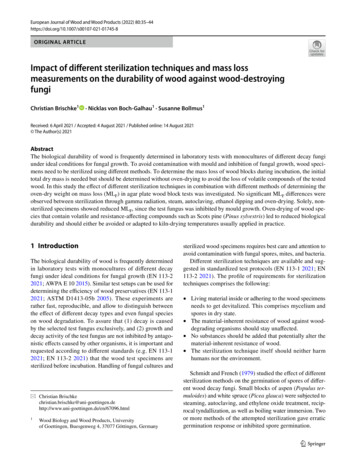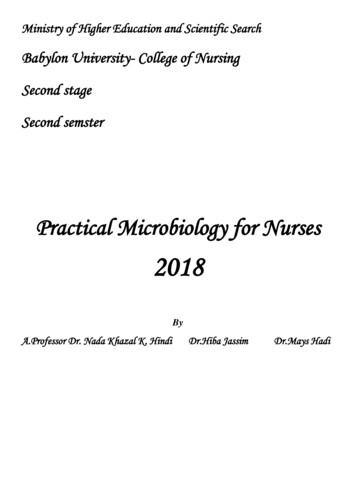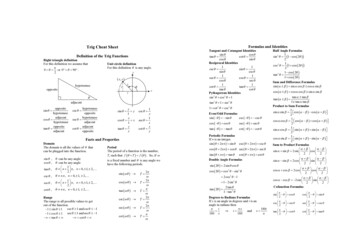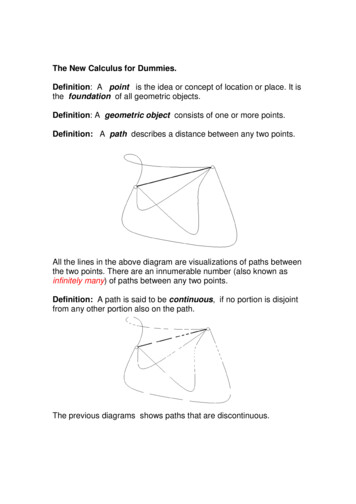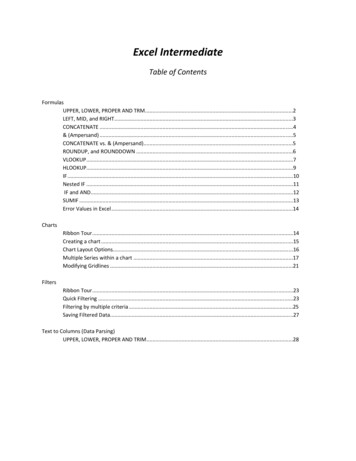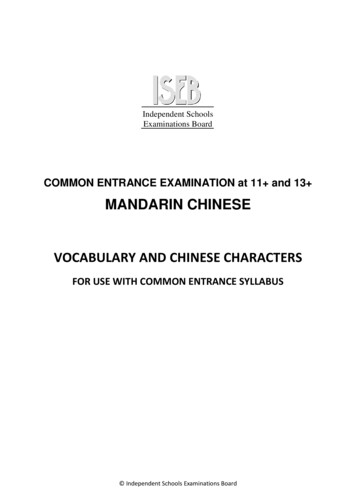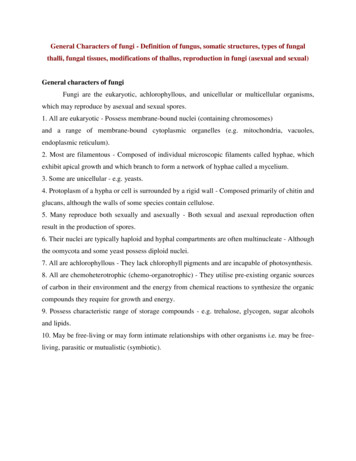
Transcription
General Characters of fungi - Definition of fungus, somatic structures, types of fungalthalli, fungal tissues, modifications of thallus, reproduction in fungi (asexual and sexual)General characters of fungiFungi are the eukaryotic, achlorophyllous, and unicellular or multicellular organisms,which may reproduce by asexual and sexual spores.1. All are eukaryotic - Possess membrane-bound nuclei (containing chromosomes)and a range of membrane-bound cytoplasmic organelles (e.g. mitochondria, vacuoles,endoplasmic reticulum).2. Most are filamentous - Composed of individual microscopic filaments called hyphae, whichexhibit apical growth and which branch to form a network of hyphae called a mycelium.3. Some are unicellular - e.g. yeasts.4. Protoplasm of a hypha or cell is surrounded by a rigid wall - Composed primarily of chitin andglucans, although the walls of some species contain cellulose.5. Many reproduce both sexually and asexually - Both sexual and asexual reproduction oftenresult in the production of spores.6. Their nuclei are typically haploid and hyphal compartments are often multinucleate - Althoughthe oomycota and some yeast possess diploid nuclei.7. All are achlorophyllous - They lack chlorophyll pigments and are incapable of photosynthesis.8. All are chemoheterotrophic (chemo-organotrophic) - They utilise pre-existing organic sourcesof carbon in their environment and the energy from chemical reactions to synthesize the organiccompounds they require for growth and energy.9. Possess characteristic range of storage compounds - e.g. trehalose, glycogen, sugar alcoholsand lipids.10. May be free-living or may form intimate relationships with other organisms i.e. may be freeliving, parasitic or mutualistic (symbiotic).
ThallusThe body of the fungus is called as 'thallus'.Eucarpic thallusThe thallus is differentiated into vegetative part, which absorbs nutrients, and areproductive part, which forms reproductive structure. Such thalli are called as eucarpic. e.g.Pythium aphanidermatum.Holocarpic thallusThe thallus does not show any differentiation on vegetative and reproductive structure.After a phase of vegetative growth, it gets converted into one or more reproductive structures.Such thalli are called as 'holocarpic' e.g. yeast, Synchytrium endobioticumHyphaeHyphae is a tubular, transparent filament, usually branched, composed of an outer cellwall and a cavity (lumen) lined or filled with protoplasm including cytoplasm. Hyphae aredivided into compartments or cells by cross walls called septa and are generally called as septate(with cross wall) or coenocytic (aseptate -without cross wall). Hyphae of most of the fungimeasure 5-10 μmacross.
Mycelium (pl. Mycelia)The hyphal mass or network of hyphae constituting the body (thallus) of the fungus iscalled as mycelium. The mycelium of parasitic fungi grows on the surface of the host and spreadbetween the cells and it is called intercellular mycelium. The mycelium of parasitic fungi, whichgrows on the surface of the host and penetrates into the host cells and is called intracellularmycelium. If the mycelium is intercellular, food is absorbed through the host cell walls ormembrane. If the mycelium penetrates into the cells, the hyphal walls come into direct contactwith the host protoplasm. Intercellular hyphae of many fungi, especially of obligate parasites ofplants (fungi causing downy mildews, powdery mildews and rusts) obtain nutrients throughhaustoria.Monokaryotic mycelium (uninucleate)Mycelium contains single nucleus that usually forms part of haplophase in the life cycleof fungi.Dikaryotic mycelium (binucleate)Mycelium contains pair of nuclei (dikaryon), which denotes the diplophase in the lifecycle of fungi.Homokaryotic myceliumThe mycelium contains genetically identical nuclei.
Heterokaryotic myceliumThe mycelium contains nuclei of different genetic constituents.MultinucleateThe fungal cell contains more than 2 nuclei.SeptaTransverse septa occur in the thallus of allfilamentous fungi to cut off reproductive cells fromthe rest of the hypha, to separate off the damagedparts or to divide the hypha into regular or irregularcompartments or cells. There are two general types ofsepta in fungi viz., primary and adventitious. Theprimary septa are formed in association with nucleardivision and are laid down between daughter nuclei. The adventitious septa are formedindependently of nuclear division and are especially associated with changes in the concentrationof the protoplasm as it moves from one part of the hypha to another.Transverse septaSepta vary in their construction septa have biological importance in the lifecycle of fungi.Some are simple whereas others are complex. All types of septa are formed by centripetal growthfrom the hyphal wall inward. In some septa, the growth continues until the septum is a solidplate. In others the septum remains incomplete, leaving a pore in the centre that may often beplugged or occulted.Some groups of Basidiomycetes like Auriculariaceae, Tremellaceae, Aphyllophorales,Agaricales etc (except Ustilaginales and uredinales) have more complex septa. Surrounding thecentral pore in the septum is a curved flange of wall material, which is thickened to form abarrel-shaped or cylindrical structure surrounding the pore. Septa of this type are termed doliporesepta (L. dolium a large jar or cask i . e., barrel).These septa are often overlaid by perforated cap, which is an extension of theendoplasmic reticulum. This cap is known as parenthosome or pore cap. Despite these apparentbarriers, there is a good cytoplasmic continuity between adjacent cells. The septal pore may varyin width from 0.1 to 0.2 μm. Dolipore septa are found in both monokaryotic and dikaryoticmycelia.
Fungal cell structureFungal cells are typically eukaryotic and have distinguished characteristics than that ofbacteria, and algae. The chief components of cell wall appears to be various types ofcarbohydrate or their mixtures (upto 80-90%) such as cellulose, pectose, callose etc., cellulosepredominates in the cell wall of mastigomycotina (lower fungi) while in higher fungi chitin ispresent. The living protoplast of the fungal cell is enclosed in a cell membrane called as plasmamembrane or plasmalemma. Cytoplasm contains organelles such as nucleus, mitochondria, Golgiapparatus, ribosomes, vacuoles, vesicles, microbodies, endoplasmic reticulum, lysosomes andmicrotubules.The fungal nucleus has nuclear envelope comprising of two typical unit membrane and acentral dense area known as nucleolus, which mainly consist of RNA. In multinucleate hyphae,the nuclei may be interconnected by the endoplasmic reticulum. Vacuoles present inside the cellprovide turgor needed for cell growth and maintenance of cell shape. Beside the osmoticfunction, they also store reserve materials. The chief storage products of fungi are glycogen andlipid. The apex of the hyphae are usually rich in vesicles and are called as apical vesicularcomplex (AVC) which helps in the transportation of products formed by the secretary action ofgolgi apparatus to the site where these products are utilized.Specialized Somatic StructuresRhizoidA rhizoid (Gr. rhiza root oeides like) is ashort, root-like filamentous outgrowth of the thallusgenerally formed in tufts at the base of small unicellularthalli or small porophores. Rhizoid serves as anchoringor attachment organ to the substratum and also as anorgan of absorption of nutrients from substratum.Rhizoids are short, delicate filaments that containprotoplasm but no nuclei.Rhizoids are common in lower fungi like Chytridiomycetes, Oomycetes andZygomycetes. Some species produce a many-branched rhizomycelium. This is an extensiverhizoidal system that usually do not contains nuclei, but through which nuclei migrate. e.g.
Cladochytrium sp. On rhizomycelium numeroussporangia develop. Such thalli are polycentric, thatis, they form several reproductive centres instead ressoriumAppressorium (p1. appressorium; L. apprimere to press against) is a simple or lobedstructure of hyphal or germ tube and a pressing organ from which a minute infection peg usuallygrow and enter the epidermal cellof the host. It helps germ tube orhypha to attach to the surface ofthe host or substrates. Theseappressoria are formed from germtubes of Uredinales (rust fungi),Erysiphales(powderymildewfungi) and other fungi in theirparasitic or saprophytic stages. In addition to giving anchorage, appressoria help the penetratinghyphae, branches to pierce the host cuticle. In fungi like Colletotrichum falcatum, germ tubesfrom conidia and resulting hyphae form appressoria on coming in contact with any hard surfacelike soil etc. These appressoria are thought to function as resting structures (chlamydospores)also.HaustoriaHaustoria (sing. haustorium; L. haustor drinker) are special hyphal structures oroutgrowths of somatic hyphae sent into the cell to absorb nutrients. The hyphal branch said tofunction as haustorium becomes extremely thin and pointed while piercing the hast cell wall andexpands in the cell cavity to form a wider, simple or branched haustorium. Haustoria may beknob-like or balloon – like in shape, elongated or branched like a miniature root system.The hyphae of obligate parasites of plants like downy mildew, powdery mildew or rust fungi lateblight fungus etc ., produce haustoria. Hyphopodia: Hyphopodium (pl. hyphopodia Gr. hyphe web pous foot) is a small appendage with one or two cells in length on an external hypha andfunction as absorbing structures. The terminal cell of hyphopodium is expanded and rounded or
pointed. Sometimes it produces a haustorium. e.g. Ectophytic fungi (Meliola aesariae) attackingleaves of green plants.Aggregations of hyphae and tissuesa. Mycelial strandMycelial strands are aggregates of parallel or interwoven undifferentiated hyphae, whichadhere closely and are frequently anastomosed or cemented together. They are relatively loose(e.g. Sclerotium rolfsii growth on culture medium) compared to rhizomorph. They have no welldefined apical meristem. Mycelial strand formation is quite common in Basidiomycetes,Ascomycetes and Deuteromycetes. Mycelial strands form the familiar 'spawn' of the cultivatedmushroom, Agaricus bisporus. Mycelial strands are capable of translocating materials in both thedirections. They are believed to afford means by which a fungus can extend an established foodbase and colonize a new substratum, by increasing the inoculum potential of the fungus at thepoint of colonization.b. RhizomorphRhizomorph (Gr. rhiza root morphe shape) is the aggregation of highlydifferentiated hyphae with a well defined apical meristem, a central core of larger, thin walled,cells which are often darkly pigmented. These root-like aggregation is found in the honey fungusor honey agaric Armillariella mellea ( Armillaria mellea). They grow faster than the mycelialstrands. The growing tip of rhizomorph resembles that of a root tip. The fungus may spreadunderground from one root system to another by means of rhizomorph.
c. Fungal tissuesDuring certain stages of the life cycle of most fungi, the mycelium becomes organizedinto loosely or compactly woven tissues. These organized fungal tissues are called plectenchyma(Gr. plekein to weave encyma infusion i.e., a woven tissue). There are two types ofplectenchyma viz., prosenchyma and pseudoparenchyma. When the tissue is loosely woven andthe hyphae lie parallel to one another it is called prosenchyma (Gr. pros toward enchyma infusion, i.e., approaching a tissue). These tissues have distinguishable and typical elongatedcells. Pseudoparenchyma (Gr. Pseudo false) consists of closely packed, more or lessisodiametric or oval cells resembling the parenchyma cells of vascular plants. In this type oftissues hyphae lose their individuality and are not distinguishable. Cells in prosenchyma are thinwalled and cells in pseudoparenchyma.Stroma and sclerotiumStromata and sclerotia are somatic structures of fungi.i. Stroma (pl. stromata; Gr. stroma mattress)A stroma is a compact, somatic structure or hyphal aggregation similar to a mattress or acushion, on which or in which fructifications of fungi are usually formed. They may be ofvarious shapes and sizes. Hyphal masses like acervuli, sporodochia, pionnotes etc. are the fertilestromata, which bear sporophores producing spores.ii. Sclerotium (pl. sclerotia; Gr. skeleros hard)A sclerotium is a resting body formed byaggregation of somatic hyphae into dense, rounded,flattened, elongated or horn-shaped dark masses.They are thick-walled resting structures, whichcontain food reserves. Sclerotia are hard structuresresistant to unfavourable physical and chemicalconditions. They may remain dormant for longerperiods of time, sometimes for several years and germinate on the return of favourableconditions. The sclerotia on germination may be myceliogenous and produce directly themycelium e.g. Sclerotium rolfsii, Rhizoctonia solani and S. cepivorum (white rot of onion).
They may be sporogenous and bear mass of spores. e.g. Botrytis cinerea. They may also becarpogenous where in they produce a spore fruit ( ascocarps or basidiocarps) bearing stalk. e.g.Sclerotinia sp. Claviceps purpurea (ergot of rye). Development of ascocarps is seen inSclerotinia, where stalked cups or apothecia, bearing asci, arise from sclerotia. In Clavicepspurpurea, sclerotia germinate and give rise to drumstick like structures called perithecialstromata, which contain perithecia, flask-shaped cavities within which the asci are formed.MycorrhizaeMycorrhiza (pl. mycorrhizae; Gr. mykes mushroom rhiza root) is the symbioticassociation between higher plant roots and fungal mycelia. Many plants in nature havemycorrhizal associations. Mycorrhizal plants increase the surface area of the root system forbetter absorption of nutrients from soil especially when the soils are deficient in phosphorus.The nature of association is believed to be symbiotic (mutualism), non-pathogenic orweakly pathogenic. There are three types of mycorrhizal fungal associations with plant roots.They are ectotrophic or sheathing or ectomycorrhiza,. endotrophic or endomycorrhiza on is the formation of new individuals having all the characteristics typical ofa species. The fungi reproduce by means of asexual and sexual or parasexual reproduction.Asexual reproduction is sometimes called somatic or vegetative and it does not involve union ofnuclei, sex cells or sex organs. The union of two nuclei characterizes sexual reproduction.ASEXUAL REPRODUCTIONIn fungi, asexual reproduction is more important for the propagation of species. Asexualreproduction does not involve union of sex organs (gametangia) or sex cells (gametes) or nuclei.In fungi the following are the common methods of asexual reproduction.
1. Fragmentation of myceliumMycelial fragments from any part of the thallus may grow into new individuals whensuitable conditions are provided.2. Fission of unicellular thalliIt is also known as transverse cell division. Reproduction by the method of fission is arein fungi. Fission is simple splitting of cells into two daughter cells by constriction and theformation of a cell wall. It is observed in Schizosaccharomyces spp3. BuddingBudding is the production of a small outgrowth (bud)from a parent cell. As the bud is formed, the nucleus of theparent cell divides and one daughter nucleus migrates into thebud. The bud increases in size, while still attached to the parentcell and eventually breaks off and forms a new individual. It iscommon in yeasts.(Saccharomyces sp. ).Scanning electron micrograph of the budding yeast Saccharomyces cerevisiae.
4. Production of asexual sporesReproduction by the production of spores is very common in many fungi.SPORESThe term 'spore'(Gr. spora seed, spore) is applied to any small propagative, reproductiveor survival unit, which separates from a hypha or sporogenous cell and can grow independentlyinto a new individual. Spores may be unicellular or multicellular. Multicellular spores are mostlywith transverse septa and in some genera like Alternaria a spore will have both transverse andlongitudinal septa. Each cell of a multicellular spore may be uninucleate, binucleate ormultinucleate depending on the fungal species. The spores may be in different shapes and sizes.They may be spherical, oval or ovate, obovate, pyriform, obpyriform, ellipsoid,cylindrical, oblong, allantoid, filiform or selecoid, falcate or fusion. The spores may be with orwithout simple or branched appendages. The spores may be motile or nonmotile. If the sporesare motile they are called planospores (Gr. Planets wanderer) and non-motile spores are calledaplanospores. Spores may be thin or thick-walled, hyaline or coloured, smooth or withornamented walls. The following types of ornamentations are found on the walls.Asexual sporesThe spores produced asexual means are:a. Sporangiosporesb. Conidiac. Chlamydosporesa. SporangiosporesSporangiospores may bemotile(planospores)ornon-motile spores (aplanospores). Insimpler fungi sporangiospores areusually motile and are calledzoospores.Thesesporesareproduced in lower fungi, whichinhabit aquatic or moist terrestrialsubstrates. sporangiospores are formed in globose or sac-like structure called sporangium (pl.sporangia; Gr. Spora seed, spore angeion vessel). In the zygomycetes and especially in the
Mucorales, the non-motile asexual spores called aplanospores are contained in globose sporangiasurrounding a central core or columella. Sporangia are also known in which there is nocolumella, or where the spores (aplanospores) are arranged in a row inside a cylindrical sactermed a Merosporangium (e.g. Syncephalastrum spp. Mucorales).These aplanospores may be uni or multinucleate and are unicellular, generally smoothwalled, globose or ellipsoid in shape. When aplanospores mature, they may be surrounded bymucilage and rain splash or insects usually disperse such spores. When aplanospores are dry thenare dispersed by wind currents. The sporangiospores for sporangium may vary from severalthousands to only one. In some fungi few-spores sporangia are called Sporangiola. Sporangiolaare dispersed as a unit. e.g. Choanephora sp. and Blakeslee sp. in Choanephoraceae ofMucorales. In holocarpic thalli, the entire thallus (without differentiation of a sporophore)becomes a sporangium. Its contents cleave into a number of segments which round off andbecome zoospores. In eucarpic thalli, a part of the thallus, or special branches from thallus,function as or produce sporangia.In terrestrial and plant parasitic forms of lower fungi, the sporangium may function asspore and no zoospores are formed. In others zoospores are formed within the sporangium itselfor the inner wall of the sporangium may grow out into a short or long tube which swells to forma vesicle. The contents of the sporangium move into a vesicle and the zoospores aredifferentiated. E.g. Pythium aphanidermatum.Zoospore (Gr. Zoon animal spora seed, spore)It is an asexually produced spore, which is motile by means of flagellum or flagella.Zoospore is naked and its covering is only a hyaloplasm membrane. Normally, zoospores areuninucleate and haploid. Zoospores may be spherical, oval, pyriform, obpyriform, elongate orreniform in shape. The zoospores are provided with one or two flagella (sing. flagellum, L.flagellum whip) for its movement in the surrounding film of water. Flagellum is a hair-or tinsellike structure that serves to propel a motile cell.These flagella may be anterior, posterior or laterally attached to a groove in the body.There are two types of flagella in zoospores. They are whiplash and tinsel types. The whiplashflagellum has a long rigid base composed of all the eleven fibrils and a short flexible end formedof the two central fibrils only. The tinsel flagellum has a rachis, which is covered on all sidesalong its centre length with short fibrils. In uniflagellate zoospores the flagellum may be anterior
or posterior. But in biflagellate zoospores one is whiplash and the other is tinsel type and onepoints forward and the other backward. But in Plasmodiophorales fungi flagella are of whiplashtype and unequal.Zoospores pass through the three phases viz., motility, encasement and germination. Thelength of their motility depends on available moisture, temperature and presence of stimulatoryor inhibitory substances in the environment. Later the zoospores become sluggish, spend or casttheir flagella (except in chytridiacious fungi and primary zoospores in Saprolegniales whereflagella are shed but withdrawn into its body become spherical and secrete thin wall around itselfand become encysted. The encysted zoospores germinate. The functions of zoospores includeinitiation of new generation and acting as gametes.b. ConidiosporesConidiospores or conidia (sing. Conidium) areasexual reproductive structures borne on special sporebearing hyphae conidiophores. They are found in manydifferent groups of fungi, but especially in eansInofmay beborne singly or in chains or incluster. They vary from unicellular(e.g. Colletotrichum), bicellular,microconidia of Fusarium spp. andmulticellular(Pestalotiopsis,Cercospora). One-celled spores arecalled amerospores, two celledsporesaredidymosporesandmulticellular spores are calledphragmospores. The multicellular conidia may be divided by the septa in one to three planes. InAlternaria spp., conidia are with both transverse and longitudinal septa are called dictyospores.The shape of the conidium may vary. They may be globose, elliptical, ovoid, cylindrical,branched or spirally coiled or star-shaped (staurospores). The colour of the conidia may be
hyaline (hyalospore) or coloured (phaeospore) pink, green, or dark. The dark pigments areprobably melanins. The colour of the conidia and conidiophores are important features used inclassification. In the order Entomophthorales (e.g. Basidiobolus, Pilobolus) asexual reproductionis by means or forcibly discharged uninucleate or multinucleate primary conidia. On germinationprimary conidia develops uninucleate or binucleate secondary conidia. In species of Fusariumone or two-celled microconidia and many-celled macroconidia are common.Conidia may be formed in acropetal (oldest conidium at the base and the youngest at theapex) or basipetal (oldest conidium at the apex and youngest at the base) succession. Generallythe term 'conidia'is used for any asexual spores other than sporangia and spores formed directlyby hyphal cells. When the spore is not much differentiated from the cells of the conidiophore inshape the term oidium is often used for conidia. A distinction between sporangiospores andconidia is that, before germination of sporangiospores a new wall, eventually continuous with thegerm tube, is laid down within the original spore wall whilst in conidia there is no new wall layerlaid down. Conidiophores are also known as sporophores. They are special hyphae bearingconidia.They may be free, simple or branched. They may be distinct from each other or may beaggregated to form compound sporophores or fruiting bodies such as synnemata, sporodochia,acervuli and pycnidia. They may be provided with sterigmata or specialized branches on whichthey bear conidia. Some conidial spores are inflated at the tips (e.g. Aspergillus); others areinflated at intervals, forming kneelike structures on which the conidia are grouped(Gonatobotrys); still others have many branches, which are characteristically arranged, in whorls(Verticillium) or in sympodium (Monopodium). They are generally produced on the surface ofthe host. The sporogenous part of the conidiophore is commonly apical but may be laterallyplaced. The apical zone of differentiation of conidiophore may give rise to a single conidium ormore often, to a succession of conidia in chains, false heads.c. ChlamydosporesChlamydospore (Gr. Chlamys mantle spora seed, spore) is a thick-walled thallicconidium that generally function as a resting spore. Terminal or intercalary segments ormycelium may become packed with food reserves and develop thick walls. The walls may becolourless or pigmented with dark melanin pigment.
These structures are known as chlamydospores. e.g. Fusarium, Mucor racemosus, Saprolegnia.Generally there is no mechanism for detachment and dispersal of chlamydospores. They becomeseparated from each other by the disintegration of intervening hyphae. They are the importantorgans or asexual survival in soil fungi. When chlamydospores are found in between fungal cellsthey are called 'intercalary chlamydospores'. Chlamydospores produced at the apex of the hyphaare called 'apical or terminal chlamydospores'.
SEXUAL REPRODUCTIONSexual reproduction in fungi involves union of two compatible nuclei. The nuclei may becarried in motile or non-motile gametes, in gametangia or in somatic cells of the thallus.Phases of sexual reproductionThree typical phases occur in sequence during the sexual reproduction.1. PlasmogamyIn plasmogamy (Gr. plasma a molded object, i.e. a being gamos marriage, union)anastomosis of two cells or gametes and fusion of their protoplasts take place. In the process thetwo haploid nuclei of opposite sexes (compatible nuclei) are brought together but eh nuclei willnot fuse.2. KaryogamyThe fusion of two haploid nuclei brought together as a result of plasmogamy is calledkaryogamy (Gr. karyon nut, nucleus gamos marriage). This stage follows immediatelyafter plasmogamy in many of the lower fungi or may be delayed in higher fungi. In higher fungiplasmogamy results in a binucleate cell containing one nucleus from each cell. Such a pair ofnuclei is called dikaryon(NL. Di two Gr. karyon nut). These two nuclei may not fuse untillater in the life history of the fungus. Meanwhile, during growth and cell division of thebinucleate cell, the dikaryotic condition may be perpetuated from cell to cell by conjugatedivision of the two closely associated nuclei and by the separation of the resulting sister nucleiwith two daughter cells. Nuclear fusion, which eventually takes place in all sexually reproducingfungi, is followed by meiosis.
3. MeiosisKaryogamy results in the formation of a diploid (2n) nucleus. Meiosis (Gr.meiosis reduction) reduces the number of chromosomes to haploid and constitutes the thirdphase of the sexual reproduction. This nucleus undergoes a reduction division to form twohaploid nuclei each with 'n'chromosomes. A mitotic division follows and four nuclei are formed.In ascomycetes another nuclear division takes place resulting in the formation eight nuclei. Thenuclei get surrounded by a small amount of cytoplasm and secrete a wall to become spores.In a true sexual cycle, the above three phases occur in a regular sequence and usually atspecified points. If there is only one free living thallus, haploid or diploid in the life cycle of afungus is called haplobiontic (Gr. haplos single bios life). e.g. Oomycetes haploid gameteand diploid mycelium. If a haploid thallus alternates with a diploid, the life cycle is calleddiplobiontic (Gr. diplos double bios life). e.g. Allomyces (water mold Coelomomyces,mosquito parasite) and in some yeasts.Organs involved in sexual reproductionFungi, which produce morphologically distinguishable male and female sex organs ineach thallus, are called hermaphroditic (Gr. hermes the messenger of the Gods, symbol of themale sex aphrodite the Goddess of love, symbol of female sex) or monoecious or unisexual(Gr. monos single, one oikos dwelling, home). A single thallus of a monoecious fungi canreproduce sexually by itself if it is self-compatible. In a fungus when the female and male organsare produced on two different thalli it is said to be dioecious or bisexual. (Gr. dis twice, two oikos home; i.e.; the sexes separated into two different individuals). Normally a single thallusof a dioecious fungus cannot reproduce sexually by itself as the thallus is either male or female.The sex organs of fungi are called gametangia (sing. gametangium; Gr. gametes husband angeion vessel, container). Sex cells are called gametes and the mother cells (sexorgans) are called gametangia. If the gametes and gametangia produced are morphologicallyidentical or similar they are called as isogametes (Gr. ison equal) and isogametangiarespectively. When the gametes and gametangia produced differ in size and structure(morphologically different) they are called heterogametes (Gr. heteros other, different) andheterogametangia respectively. In the latter case, the male gametangium is called antheridium(pl. antheridia; Gr. antheros flowery idion, dimin. suffix) and the female gametangium is
called oogonium (pl. oogonia; Gr. oon egg gonos offspring). The male gamete is known asantherozoid or sperm and the female as an egg or oosphere.Methods of sexual reproductionThe following are the five methods, which the fungi employ to bring the compatiblenuclei together for fusion.1. Planogametic copulation2.Gametangial contact (Gametangy)3. Gametangial copulation (Gametangiogamy)4. Spermatization5. Somatogamy1. Planogametic copulation or conjugationA planogamate is a motile gamete or sex cell. The fusion of two gametes, one or both of whichare motile is called planogametic copulation. This type of sexual reproduction is common inaquatic fungi. There are three different types of planogametic copulation.a. Copulation of isogamousmotile gametesIn this type morphologicallysimilar butcompatible typeof mating type of gametesunite to form a motilezygote. e.g. Synchytrium.b. Copulation in anisogamous motile gametesIt involves union of one
The chief components of cell wall appears to be various types of carbohydrate or their mixtures (upto 80-90%) such as cellulose, pectose, callose etc., cellulose predominates in the cell wall of mastigomycotina (lower fungi) while in higher fungi chitin is present. The living protoplast of the fungal cell is enclosed in a cell membrane called .

